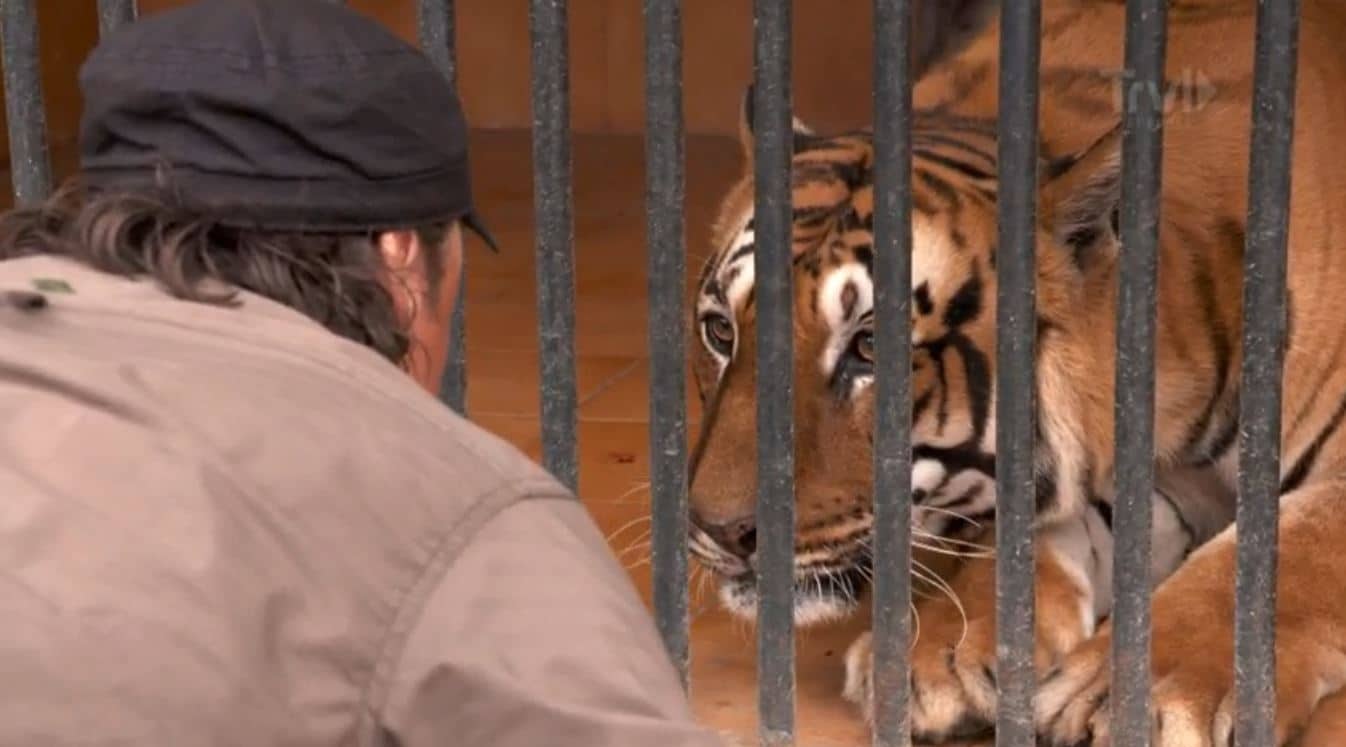
On tonight’s Monster Encounters on Travel Channel, host and wildlife expert Casey Anderson does something that will make the hair stand up on the back of your neck.
Casey turns his back on a man-eating tiger to demonstrate how the animals hunt prey, especially humans.
In the Monster Encounters clip, Anderson says: “Tigers strike from primarily behind, so I’m going to show Bhangay [the tiger] my back to put him in attack mode, then see how his demeanor changes when I turned to face him eye to eye.”

Travel Channel’s series Monster Encounters is a wild ride and Anderson — a wildlife expert, naturist, and explorer who had a grizzly bear as a best man at his wedding — is right at the top of his game.
His expertise has been called upon in the past to curate expeditions for other channels including Nat Geo Wild. Now in this new series for Travel Channel he gives us the real lowdown on some of nature’s most fearsome creatures and why they strike.
But the action tonight is all about the tiger. In countries like Nepal and India, man-eaters are a problem, and Anderson talks about this issue and how the species in under duress to coexist with humanity, preserving their natural numbers.
The clip shows how Anderson understands the predatory behavior of this big cat, as he turns around and locks eye with the enormous Banghay, putting a halt to the impending strike.
But the animal makes no bones about which one of them should be more scared, as he growls in Anderson’s face while showing off canine teeth more than four inches long.

Monsters and Critics spoke to Casey Anderson ahead of this amazing episode to get the low down:
Monsters and Critics: Tigers — how in danger are they?
Casey Anderson: There are less than four thousand wild tigers in the world. I was tracking tigers in Nepal where there has been a huge success in the conservation and recovery of tigers in national parks. Since 2009, when there were only 120 tigers, the population has doubled.
M&C: Where were you?
Casey: I spent my time in Nepal tracking man-eating tigers, meeting their recent victims who survived, and family of those who did not. If I was to wander in the jungle that’s home to these killers, I wanted to test and prove my theory at the zoo before heading out.
In the clip, I was at Kathmandu Central Zoo. In the country of Nepal it is their policy not to kill a man-eater, but to capture it. They don’t believe in killing the tigers, based on religious reasons — most Nepalese are Buddhist.
M&C: Tell me about this tiger and your methods?
Casey: The tiger I faced at the zoo was named Bhangay (a captured man killer). From my experience with big predators that are capable of killing people, I like to play a game of “cat and mouse”.
If you face large cats and stare them in the eye and stand your ground, you can actually intimidate them and cause them to back away, ultimately saving your life. This body language/behavior is the basis of the old tactic of wearing masks on the back of your head in tiger country.
If you’re making eye contact with a large predator, they usually won’t attack.
M&C: Anything else about this episode you want to share?
Casey: Tigers are greatly endangered because their natural habitat is in countries like India, Nepal, and China. And due to massive human population growth and resource needs, tiger habitat is being destroyed daily, forcing tigers into small isolated pockets of habitat, usually national parks.
Also, Asian traditional medicine uses tiger body parts, so there is a massive amount of poaching that occurs.
Any conservation effort is all about balance. While there is a big local movement to protect the tigers that has been successful, their food sources, such as native wild deer, are disappearing — and the tiger has to eat something.
The next best thing, when they are desperate, are all the humans that live around them.
This dangerous recipe, big cats that are predatory and desperate, surrounded by a lot of people, is the very thing that makes it a man-eater and more deadly than other big cats of the world.
The country of Nepal values their natural resources and has lived side by side with tigers forever. Through education, social tolerance, and tiger habitat conservation there is still hope that the tiger will not go extinct.
Monster Encounters: Man-Eating Tigers airs Tuesday, November 6, at 10 pm ET/PT on Travel Channel.